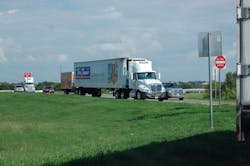Anything but, actually, as anyone in the trucking business will tell you.
That “simple” move is highly complicated, with driver pay, equipment costs, fuel costs, regulatory compliance, weather, roadway speed, traffic congestion, and about a couple other hundred factors and sub-factors thrown into the mix. Mess up just a couple of them, and suddenly, the shipment is late and your costs are way out of line, with anger and red ink to follow.
And that’s just when examining one truck and one shipment in detail, mind you. Keeping an entire fleet in line – whether it’s just a handful trucks or several hundred tractor-trailers in the mix – requires a higher level of Herculean undertaking.
I got recently some thoughts on this broad topic from Scott Fenwick senior director of product strategy for transportation management systems (TMS) provider Manhattan Associates, and Darren Matthews, business development analyst for software provider WiseTech Global.
Of course, both believe technology is the key to untangling the complicated Gordian knot transportation is becoming these days and so you can take their thoughts with a grain of salt from that perspective.
Yet it seems to me that, at the end of the day, technology is really the only way to keep track of the all the important and mundane details alike when moving freight – a process that determines whether a motor carrier makes money and delivers on customer expectations … or not.“Transportation decisions can impact all aspects of its business, from customer satisfaction to product availability to general profitability,” noted Fenwick (at left).
“Aside from the logistics challenges that a geographically dispersed transportation network can present, other factors – like driver shortages, changing regulations, fuel costs and global security concerns – think of the challenges of managing an international transportation system that spans continents, cultures, languages and laws,” he pointed out.
“It’s a daunting task that demands the assistance of advanced technology,” Fenwick stressed. “Without the insight provided by transportation modeling systems, managers would be left to simply imagine the challenges that await their drivers on the open road, and they would risk significant service disruptions, missed deliveries and unhappy customers as a result.”
That’s why he thinks TMS technology plays such a vital role, for it evaluates the effects of uncertainty and variability in transportation networks to allow companies – shippers and carriers alike – to more effectively manage logistics across what he calls the “dispersed ecosystem” of the business world.“The benefits of transportation modeling stem from the need to understand and control the impact of change,” Fenwick pointed out. “Modeling helps users understand – and prepare for – the impact of potential changes before they occur.”
What does that mean in the real world? Fenwick said that for shippers with large networks, for example, it helps determine which distribution centers should service which stores for which specific products, in order to optimize time, fuel and resources.
“It also helps managers create the most productive delivery schedule for their fleets, taking into account factors such as opened and closed stores, route disruptions and seasonal issues,” he explained. “It also factors in delivery window optimization, determining the best time for product delivery based on store hours, traffic, etc.”
WiseTech’s Matthews argues that companies – again, shippers and carriers alike – cannot thrive without the productivity benefits TMS technology offers. Yet he worries that ignore surrounding the potential TMS and other one-the-horizon advances may catch the transportation and logistics industry off guard.“Take driverless vehicles, for example,” Matthews (at left) said. “A recent study by EyeForTransport found that 42% of retailers and manufacturers would like 3PL companies to have some degree of knowledge about driverless vehicles."
Yet counter to this enthusiasm, however, is the position of the 3PLs themselves.
According to the study, Matthews said only 0.75% of 3PLs said they had any knowledge of driverless vehicle technology, while only 12.78% said they were even aware it existed.
But it’s the “small” advances in technology that are making big changes, he stressed.
“Today, even simple tech tools – such as POD signature capture devices, in-cab GPS, various vehicle telematics, and RF scanners – are reducing the workload of staff and speeding up processes,” Matthews explained. “But when these devices are integrated with global TMS, you not only speed up the process for a single user, you do so for the whole business,” he said. “Now accurate and timely data is readily available to all, without a second thought.”
TMS software is increasingly automating tasks to replace the manual processes historically managed by staff, Mathews noted, and just by reducing the number of documents needed for a freight shipment can ultimately deliver efficiency gai“The point is to take advantage of what’s out there, and everyone will see how you work smarter and faster on the outside, all while reducing costs and scaling your business efficiently on the inside,” he stressed.
“At the end of the day, the transportation network is what keeps a supply chain running,” added Manhattan’s Fenwick.
“That’s why managers need to anticipate the impact of change and make decisions knowing the full operational and financial impact of those decisions,” he said.
Creating order out of chaos: might sound like something out of a Greek myth, but it’s what transportation providers – especially truckers – do every day in the freight market. The challenge will be doing it faster and cheaper, all while maintaining profits, in the future.





